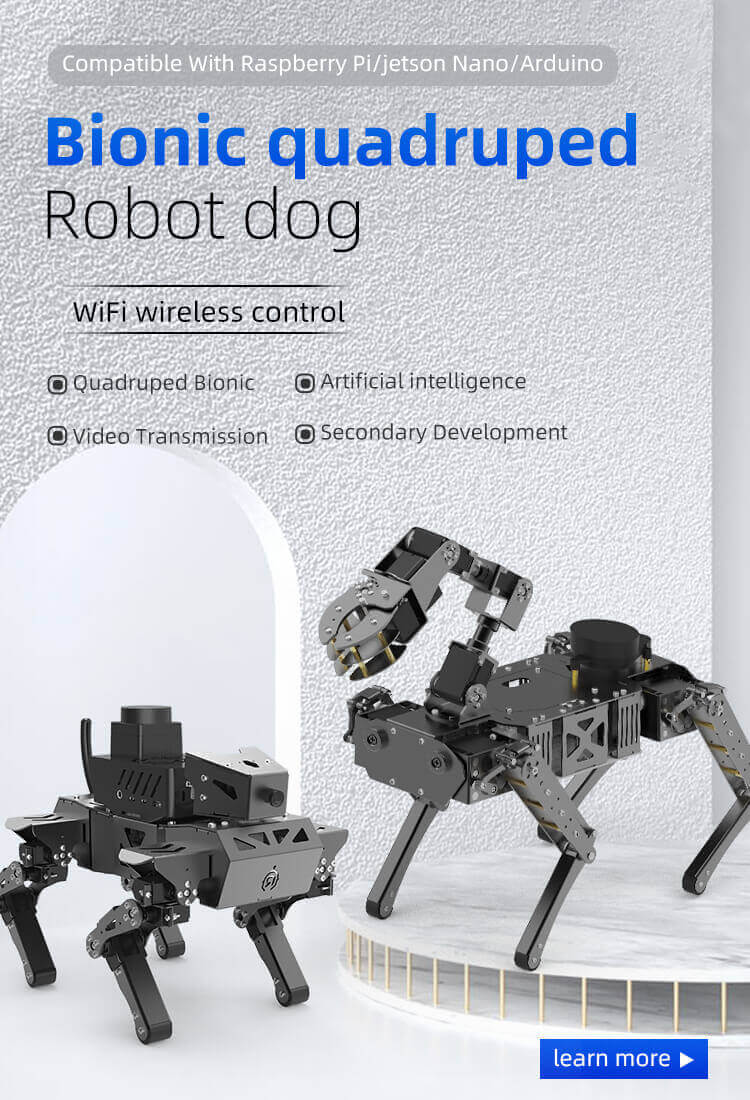The quadruped bionic robot dog is a four-legged robot that imitates real animals. It has a high degree of flexibility and stability and can walk and jump in various complex terrains and environments. The production and control of the quadruped bionic smart programmable robot dog involves multiple STEM fields, such as science, technology, engineering and mathematics. It is a teaching tool and innovation platform that is very suitable for use in K12 education in schools. This article will introduce the role and application scenarios of the ESP32 quadruped bionic robot dog in school K12 from the following aspects:
What is the ESP32 quadruped bionic robot dog?
The XR ESP32 quadruped bionic robot dog is a small quadruped robot dog based on the ESP32 development board. It uses 12 servos to drive the movement of the four legs. It uses an inverse kinematics algorithm to calculate the angle of each servo. It uses Configurable gait sequence to control the walking mode of the robot dog, supports mobile phone or tablet as a remote control to control the direction and speed of the robot dog, and uses optional external devices such as 720P HD camera, gyroscope, and current sensor to enhance Functionality and performance of the robot dog. The ESP32 quadruped bionic robot dog was produced and programmed using the Arduino IDE, which is a simple and easy-to-use open source platform that is very suitable for K12 students.
The role of ESP32 four-legged bionic robot dog in K12 schools
The role of the ESP32 quadruped bionic robot dog in school K12 mainly includes the following aspects:
• Stimulate students' interest in learning and creativity. The ESP32 quadruped bionic smart programmable robot dog is an interesting and challenging teaching tool. Its cute appearance can attract students' attention, stimulate students' curiosity and desire to explore, and allow students to learn through play and learn while having fun. The ESP32 quadruped bionic smart programmable robot dog is also an innovative platform that is highly customizable and scalable. You can add a graphical programming box and an AI intelligent expansion box by yourself. Of course, it also allows students to design and develop according to their own ideas and needs. Make your own robot dog and unleash your students' creativity and imagination.
• Develop students’ STEM literacy and abilities. The production and control of quadruped bionic robot dogs involves multiple STEM fields, such as science, technology, engineering and mathematics. It allows students to learn and master relevant knowledge and skills, such as mechanical structures and circuits, during hands-on practice. Connections, programming languages, algorithm design, data analysis, etc., to cultivate students’ STEM literacy and abilities.
• Improve students' comprehensive quality and competitiveness. The production and control of a four-legged bionic robot dog not only requires students' theoretical knowledge and technical skills, but also requires students' innovative thinking and problem-solving abilities, as well as teamwork and communication skills. By participating in the ESP32 quadruped bionic smart programmable robot dog project, students can improve their overall quality and competitiveness and prepare for future study and employment.
Application scenarios of ESP32 quadruped bionic smart programmable robot dog in K12 schools
The application scenarios of the ESP32 quadruped bionic smart programmable robot dog in K12 schools mainly include the following aspects:
• Classroom teaching. Teachers can use the ESP32 quadruped bionic smart programmable robot dog as an auxiliary tool for classroom teaching. By displaying and demonstrating the structure and functions of the robot dog, they can explain and analyze relevant STEM knowledge and principles, guide and motivate students to participate and interact, and improve the effectiveness of classroom teaching. and quality.
• Extracurricular activities. Schools can use the ESP32 quadruped bionic smart programmable robot dog as the theme and content of extracurricular activities to organize and carry out various interest groups, societies, workshops, lectures, exhibitions, etc. on the production and programming of robot dogs to enrich and expand students' extracurricular life. , cultivate and exercise students’ interests and abilities.
• Competition evaluation. Schools can use the ESP32 quadruped bionic smart programmable robot dog as a project and standard for competition evaluation, to hold and participate in robot dog production and programming competitions of various levels and scales, such as intra-school, inter-school, regional, national, international, etc., to inspire and challenge Students' sense of innovation and competition, demonstrating and evaluating students' levels and achievements.

